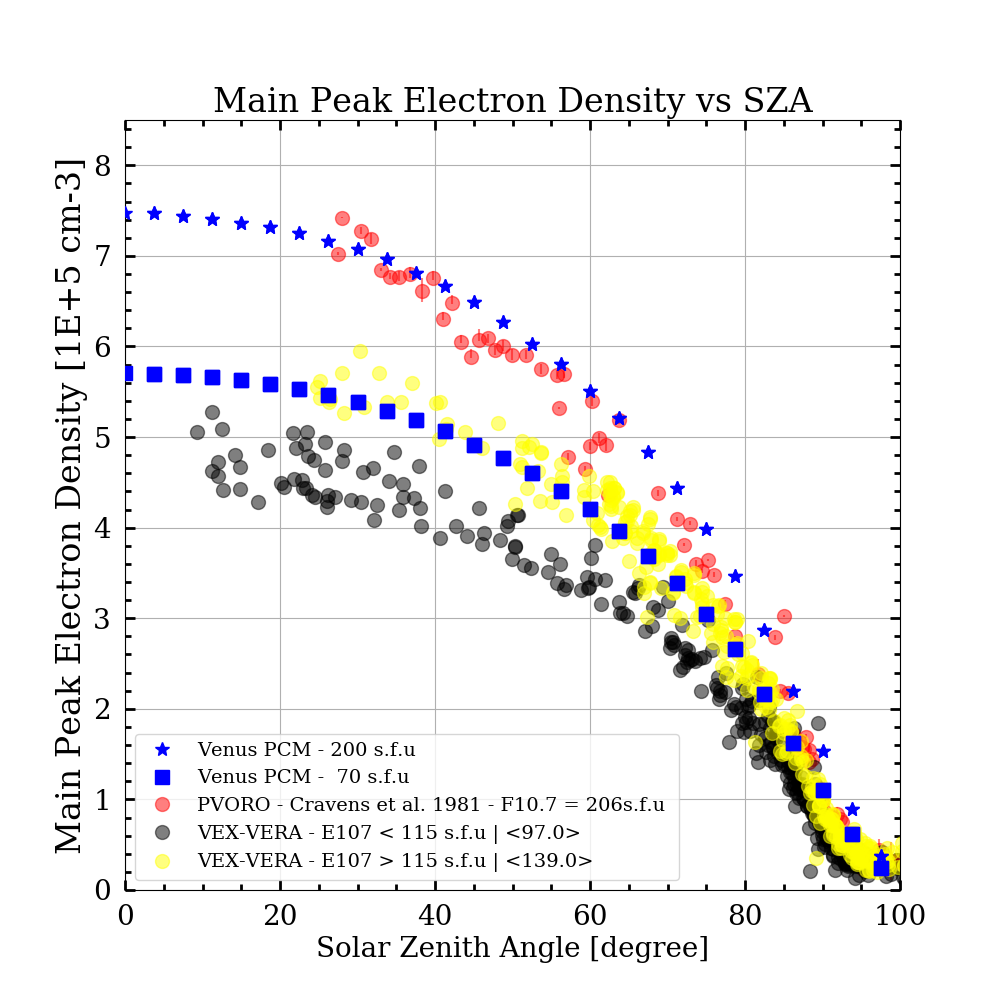Three-Dimensional Venusian Ionosphere with the Venus PCM
- 1Instituto de Astrofísica de Andalucia (IAA-CSIC) - Granada, Spain (antoine@iaa.es)
- 2LATMOS, CNRS, Sorbonne Université, Université Versailles St Quentin, Paris, France
- 3Laboratoire de Météorologie Dynamique - CNRS DR04, Paris, France
- Introduction
For twenty years, a Planetary Climate Model (PCM) has been developed for the Venus atmosphere, from the surface up to 250 km altitude ([2], [3], [4] and [5]), at “Institut Pierre-Simon Laplace” (IPSL), in collaboration with LMD (Paris), IAA (Granada) and LATMOS (Paris). With the recent implementation of the ion chemistry and ambipolar diffusion, Venus PCM (VPCM) is currently able to model the Venusian ionosphere and is validated with observations from Venus Express and Pioneer Venus.
- Recent implementations
Based on the works of [6,7], the VPCM was implemented with an ionospheric model including photoionization (13 for CO2, CO, O, NO, N2, N, H and O2) and ion chemistry (64 reactions for CO2+, CO+, O+, O2+, N2+, N+, H2O+, H3O+, HCO+, NO+, H+, C+, OH+, HCO2+ and e-), and a vertical ambipolar diffusion model. The electron temperature used in VPCM is based on the model of [8]. There is no electron impact or horizontal electromagnetic transport in this current version. These improvements are presented and discussed in more detail in [1].
The validation was performed using ion and electron number densities data from the Pioneer Venus (PV) and Venus Express (VEX) missions. These simulations provided the fields included in the Venus Climate Database 2.3 (VCD, see http://www-venus.lmd.jussieu.fr).

Figure 1: Electron number densities at the ionospheric peak versus solar zenith angle. Red circles correspond to PV data from [9] at high solar activity. Black and yellow circles correspond to the VEX observations for low solar activity and intermediate solar activity conditions, respectively. The number in brackets corresponds to the average E10.7 value for each selection of VEX-VERA data. This figure is taken from [1].
- Results and Discussions
The electron number density of the main Chapman electron peak simulated by the VPCM is consistent with the PV data of [9] from PV-ORO (Radio Occultation) observations (for high solar activity, see Figure 1). The VPCM well reproduces the evolution of the electron number density and its altitude with the solar zenith angle on the dayside. However, the VPCM overestimates by 15% the electron density peak at 140 km on the dayside at low solar activity
The ambipolar diffusion for ions is necessary above 180 km altitude. With the addition of this process, the electron number density predicted by the VPCM is in good agreement with PV observations. Below 180 km, the photochemistry processes dominate over the ambipolar diffusion and its effects are negligible as expected. Yet, the VPCM fails to reproduce the electron variation on the nightside, probably due to an underestimation of ion transport from day to night, linked to the absence of electromagnetic horizontal transport process. Day-to-night ion transport and ion chemistry will be explored in future work in order to improve the Venus PCM.
Acknowledgements
The PV-OIMS neutral densities are obtained from the Planetary Data System (PDS) (https://pds.nasa.gov/). The Venus Express/Vera data set was provided by the RIU team (Cologne University). This work was funded by ESA under the contract No. 4000130261/20/NL/CRS. The VPCM simulations were done thanks to the High-Performance Computing resources of “Tres Grand Centre de Calcul” under the allocation n°A0140110391 made by Grand Equipement National de Calcul Intensif. G.G. and A.M. acknowledge financial support from Junta de Andalucía through the program EMERGIA 2021 (EMC21 00249). The IAA team (A.M., F.G.-G., G.G.) also acknowledge financial support from the Severo Ochoa grant CEX2021-001131-S funded by MCIN/AEI/ 10.13039/501100011033. J.-.Y.C is supported by the Programme National de Planétologie (PNP, France) of CNRS-INSU co-funded by CNES and Programme National Soleil Terre (PNST, France) of CNRS-INSU co-funded by CNES and CEA.
References
[1] Martinez, A., Chaufray, J.-Y., Lebonnois, S., Gonzàlez-Galindo, F., Lefèvre, F. and Gilli, G. Icarus, 415:116035, June 2024.
[2] Lebonnois, S., Hourdin, F., Eymet, V., Crespin, A., Fournier, R., Forget, F., 2010. J. Geophys. Res. (Planets) 115, 6006. https://doi.org/10.1029/2009JE003458.
[3] Lebonnois, S., Sugimoto, N., Gilli, G., 2016. Icarus 278, 38–51. https://doi.org/10.1016/j.icarus.2016.06.004.
[4] Stolzenbach, A., Lefèvre, F., Lebonnois, S., & Määttänen, A. (2023). In Icarus (Vol. 395, p. 115447). Elsevier BV. https://doi.org/10.1016/j.icarus.2023.115447
[5] Martinez, A., Lebonnois, S., Millour, E., Pierron, T., Moisan, E., Gilli, G., Lefèvre, F., Icarus, 2023, 115272, 0019-1035, https://doi.org/10.1016/j.icarus.2022.115272
[6] González-Galindo, F., J.-Y. Chaufray, M. A. López-Valverde, G. Gilli, F. Forget, F. Leblanc, R. Modolo, S. Hess, and M. Yagi, (2013), J. Geophys. Res. Planets, 118, 2105–2123, doi:10.1002/jgre.20150.
[7] Chaufray, J.-Y., Gonzalez-Galindo, F., Forget, F., Lopez-Valverde, M., Leblanc, F., Modolo, R., Hess, S., Yagi, M., Blelly, P.-L., and Witasse, O. (2014), J. Geophys. Res. Planets, 119, 1614–1636, doi:10.1002/2013JE004551.
[8] Theis, R. F., L. H. Brace, R. C. Elphic, and H. G. Mayr (1984), J. Geophys. Res., 89, 1477–1488. https://doi.org/10.1029/JA089iA03p01477
[9] Cravens, T. E., Kliore, A. J., Kozyra, J. U., & Nagy, A. F. (1981). In Journal of Geophysical Research (Vol. 86, Issue A13, p. 11323). American Geophysical Union (AGU). https://doi.org/10.1029/ja086ia13p11323
How to cite: Martinez, A., Chaufray, J.-Y., Lebonnois, S., Gonzàlez-Galindo, F., Lefèvre, F., and Gilli, G.: Three-Dimensional Venusian Ionosphere with the Venus PCM, Europlanet Science Congress 2024, Berlin, Germany, 8–13 Sep 2024, EPSC2024-126, https://doi.org/10.5194/epsc2024-126, 2024.